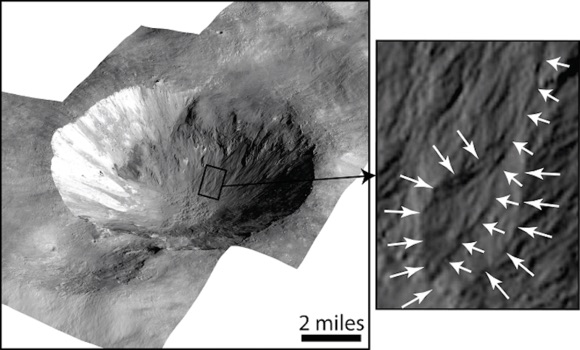The Dawn spacecraft is now very close to the dwarf planet Ceres, but there are some interesting new findings from its previous visit to the asteroid Vesta. Curved gullies on its surface suggest that small amounts of water may have once been present in the form of wet debris flows—a rather surprising discovery.
Being a small airless body, Vesta was not expected to show any evidence of water, but if the findings are accurate, then Vesta once had water in its interior, and perhaps still does. In such a cold and airless environment, it is thought that the water flowed not in rivers as such, but more in the form of short-lived wet debris flows.
According to Jennifer Scully, a postgraduate researcher at the University of California, Los Angeles (UCLA): “Nobody expected to find evidence of water on Vesta. The surface is very cold and there is no atmosphere, so any water on the surface evaporates. However, Vesta is proving to be a very interesting and complex planetary body.”
“We’re not suggesting that there was a river-like flow of water. We’re suggesting a process similar to debris flows, where a small amount of water mobilizes the sandy and rocky particles into a flow,” Scully said.
If confirmed, the finding would have interesting implications for planetary science. Not that long ago, it wasn’t known if water existed anywhere else besides Earth, but now we know that it does in the form of subsurface oceans or seas within some of the cold, icy moons of the outer Solar System, such as Europa and Enceladus, and likely others as well, including Ganymede and Titan. There may still be short-lived flows of water on the surface of Mars as well, recent evidence suggests. If water was also discovered within asteroids and/or dwarf planets, that would be an exciting addition to the kinds of worlds where it can be found.
“These results, and many others from the Dawn mission, show that Vesta is home to many processes that were previously thought to be exclusive to planets,” said UCLA’s Christopher Russell, principal investigator for the Dawn mission. “We look forward to uncovering even more insights and mysteries when Dawn studies Ceres.”
The gullies are similar to those on Earth created by movement of wet sand or other rocky material. “These features on Vesta share many characteristics with those formed by debris flows on Earth and Mars,” Scully said. They are different from gullies caused by the flow of dry material, leading scientists to suggest that water was involved, but probably in small amounts for brief periods of time, since water can’t last on the surface due to the lack of atmosphere and extreme cold. The gullies are about 100 feet (30 metres) wide on average, with an average length of just over half a mile (900 metres). A number of younger craters contain such gullies, complete with fan-shaped (lobate) deposits at their ends, which would be left after the water evaporated. Some of the most impressive gullies are located in the Cornelia crater, which is about 9 miles (15 kilometres) across.
How do the gullies actually form? At this point the primary theory is that there are small localized patches of ice underneath the surface. Impacts from other asteroids or meteoroids could melt the ice, causing water to briefly flow. Can that ice be detected if it is there? “If present today, the ice would be buried too deeply to be detected by any of Dawn’s instruments,” Scully said. “However, the craters with curved gullies are associated with pitted terrain, which has been independently suggested as evidence for loss of volatile gases from Vesta.”
The research team conducted experiments at the Jet Propulsion Laboratory (JPL) which indicated that there should be enough time for the watery debris to cut the curved gullies before the water evaporated. While Vesta itself is estimated to be 4.6 billion years old, the craters which the gullies are found in are thought to be less than a few million years old.
There is also evidence from Dawn’s visible and infrared mapping spectrometer and gamma ray and neutron detector for hydrated material within some of the rocks on Vesta’s surface. This supports the hypothesis that Vesta is still wet to some degree and not completely dry, as first thought.















